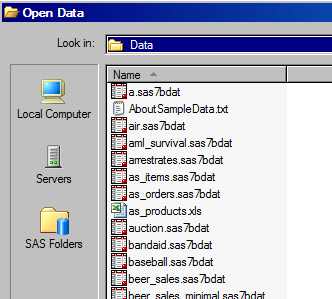

 |
 |
|
Local and Remote DataWhen you open data in SAS Enterprise Guide, you must select whether you want to look for the data on your local computer, a SAS server, or in a SAS folder. |

If you click Local Computer, you can browse the directory structure of your computer. You can open any type of data file that SAS Enterprise Guide can read. If you click Servers, you can look for your data on a server. A server can either be a local server if SAS software is installed on your own computer, or it can be a remote server if SAS software is installed on a different computer. The servers that you see depend on the repository you are connected to. Within each server there are icons that you can select for Libraries and Files. Libraries are shortcut names for directory locations that SAS knows about. Some libraries are defined by SAS, and some are defined by SAS Enterprise Guide. Libraries contain only SAS data sets. The Files folder on a server enables you to access data files in the directory structure on the computer where the SAS server is running. For example, if you wanted to open a Microsoft Excel file on a server that is defined in your repository, you would use the Files node to locate and open the file.
|
|
Next you open SAS data from your local computer. |